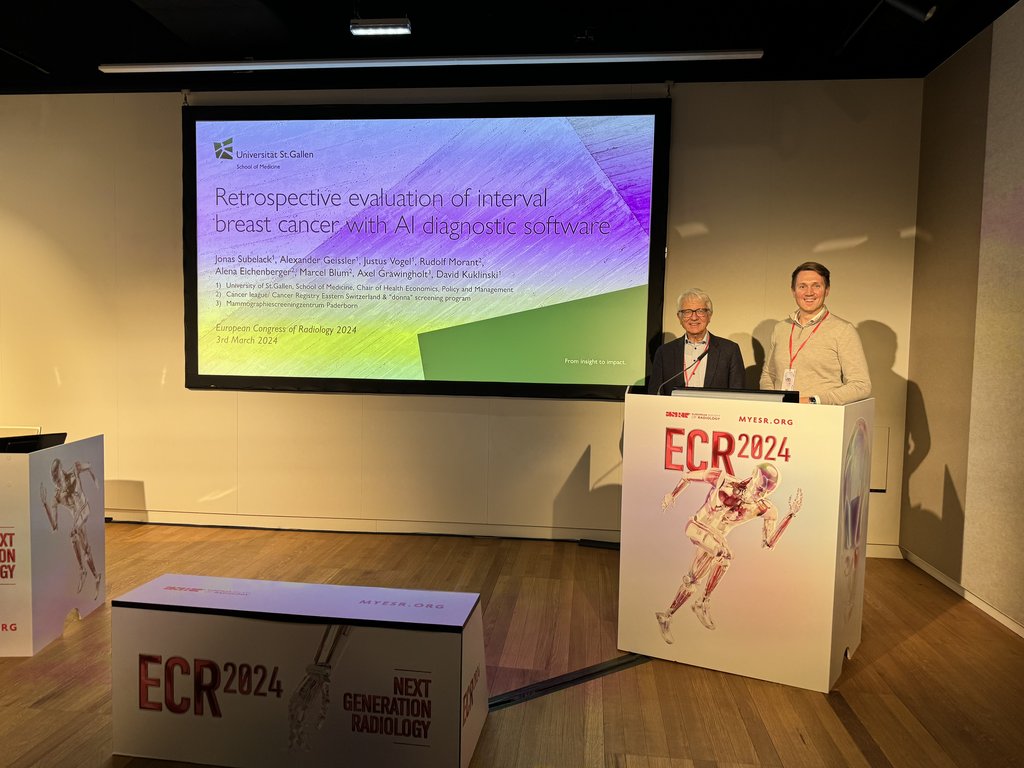Research - 04.03.2024 - 10:30
Use of Artificial Intelligence can improve breast cancer screening programmes
The research collaboration between the School of Medicine (Med-HSG) and the Cancer League of Eastern Switzerland is being continued. The main objective: quality assurance and improvement of the "donna" breast cancer screening programme. The latest results were presented yesterday in Vienna.

Objective of the research collaboration between Med-HSG and Cancer League of Eastern Switzerland: quality assurance and improvement of "donna".
Women between the ages of 50 and 69 in the cantons of St.Gallen, Graubünden and Appenzell Innerrhoden and between 50 and 74 in the cantons of Bern and Solothurn are invited to undergo a voluntary X-ray breast examination, known as a mammogram, every two years. An initial analysis of the "donna" breast cancer screening programme highlighted the importance of systematic early detection of breast cancer for women. The latest results were presented by Jonas Subelack, PhD student at the Chair of Health Economics, Policy and Management at the School of Medicine (Med-HSG), at the European Congress of Radiology on 3 March 2024. It was emphasised that:
- Results that were AI tested indicated a very high probability of breast cancer in 22.7% of (interval carcinoma) mammograms where radiologists had not diagnosed breast cancer in screening but breast cancer was detected within 24 months.
- Some of these 22.7% were investigated further, as the radiologists also saw minor abnormalities. Overall, however, the AI rated 10.1% of all mammograms with a very high probability of breast cancer where the radiologists saw nothing.
- The AI also calculated a prognostic risk classification: the risk of developing breast cancer within two years of an unremarkable mammogram. On this basis, breast cancer screening programmes could be personalised and thus become even more effective.
Early detection programmes can identify cancers at an early stage
In the first evaluation step, the researchers from the School of Medicine (Med-HSG) and experts from the Cancer League of Eastern Switzerland found that women diagnosed with breast cancer who took part in "donna" in St.Gallen and Graubünden had a significantly better 5-year survival rate (96.5%) than women outside the programme (86.1%). In addition, their breast cancer was detected at an earlier stage and the women diagnosed received less invasive treatment.
AI-based software detects interval cancers earlier
In the next step, the team investigated interval cancers, the occurrence of which is internationally regarded as an important quality indicator of a breast cancer screening programme. Interval cancers are detected between two mammograms, i.e. 24 months apart. They cannot be completely prevented, but their number should be kept as low as possible.
For the analysis, data from the "donna" breast cancer screening programme and the Eastern Switzerland Cancer Registry from 2010 to 2019 in the cantons of St.Gallen and Graubünden were evaluated. Of all interval cancers that occurred, the mammography images (previously interpreted as inconspicuous) from the early detection programme were identified. These were then analysed using the artificial intelligence-based software ProfoundAI (iCad). This was used to calculate a numerical index, a so-called 'case score', which indicates the degree of certainty that the original screening mammogram contains breast cancer compared to the training database. Secondly, the software calculates a prognostic risk classification, which indicates the risk of developing breast cancer within two years of an inconspicuous mammogram.
As a result, 22.7% of interval carcinoma mammograms had a high case score (≥60 out of 100). The risk classification showed that 25.6% of the interval carcinoma mammograms received a high risk classification. It should be noted here that the radiologists also saw some abnormalities in these mammograms and discussed them in a consensus conference or initiated further investigations. Specifically, 55.6% of all interval carcinoma mammograms with a high case score and 43.3% with a high risk classification had already been discussed in a consensus conference.
What is more interesting is that the software marked 10.1% (based on the case score) or 14.5% (based on the risk classification) of the initial mammograms of women with interval carcinoma as 'consensus conference-worthy', in which the radiologists found no abnormalities. In these cases, artificial intelligence could have improved the quality of the "donna" programme by providing the radiologists with information or bringing these cases to a consensus conference. However, the impact on the entire screening programme (e.g. expansion of consensus conferences) must be evaluated before artificial intelligence is used systematically.
Next steps
In the next steps, the research collaboration will further advance the following approaches:
- Testing large-scale use of AI in breast cancer diagnostics: the systematic use of AI software is currently being tested and will be scientifically evaluated in a timely manner. If the study results are positive, it will be used as part of the "donna" programme in addition to the radiologists and highlight cases that are discussed by several radiologists in a consensus conference. Initial international publications indicate the potential of such software applications to improve sensitivity.
- Review of interval carcinoma mammograms by radiologists: Mammograms in which an interval carcinoma has been detected are reviewed by radiologists. They assess whether the previous screening mammogram showed any or only minor indicators. These results can make an important contribution to determining the sensitivity of the programme and serve the further training of radiologists.
The detailed results of the analyses will be published in a scientific journal at a later date.
Image: Dr Rudolf Morant, President of the Cancer League, with Jonas Subelack, Med-HSG, at the European Congress of Radiology in Vienna